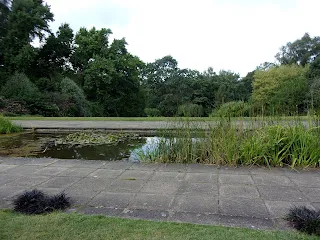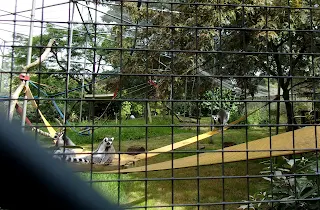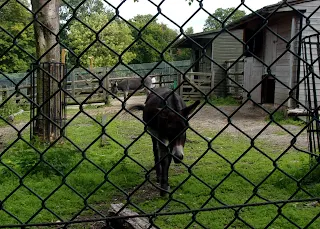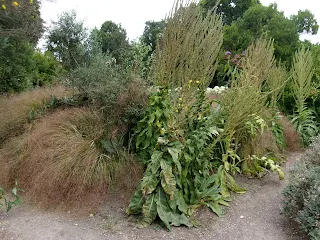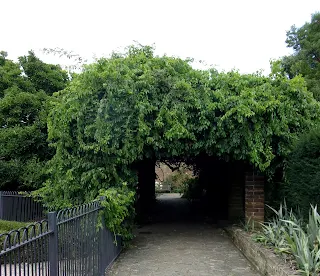We were walking to Hampstead Heath train station after visiting Golders Hill Park and were totally surprised to stumble upon the Hill Garden and Pergola. In all my years of living in London I had NEVER even heard of this, and wondered how this could be so!
Some of these photos also feature in my Golders Hill Park vlog, link:-
The Hill Garden and Pergola stretches for over 230 metres...
The view from around the corner, and there is more than one entrance...
Here's the first photo I took from the upper storey; overlooking the lower gardens from the Stone Bridge over the public Right of Way.
This little "temple" is at the end of the upper walkway, and is called the Domed Garden Building.
From the end temple structure you take a flight of steps down, and I wish I'd walked further along, as I later found out that at the end to the right is a gorgeous pond.
Oh well- my excuse to come back was sorted...
...So that's exactly what I did! I headed towards the Belvedere at the end, and the photos in this blog are taken with two cameras over two trips...
Belvedere means a viewing building, but unfortunately I was too short to see through the window!
The Hill Garden and Pergola is on more than one level...
Graffiti on the outer Belvedere wall...
I loved this old knotty, gnarled tree...
The section containing the lily pond is actually an extention to the original raised garden...
The house next door was once owned by Lord Leverhulme (1851-1925), who made a fortune manufacturing soaps from vegetable oils. He remodelled his house- called The Hill- extensively, even adding a ballroom.
This part is the Hill Garden, created after Lord Leverhulme acquired neighbouring Heath Lodge and Cedar Lodge; knocking the houses down and adding this beautiful landscaped pond.
William Hesketh Lever was created 1st Viscount Leverhulme in 1922.
The upper terrace, with a recessed seat. This is a fabulous little nook!
The views down over the lawn and, trust me, these gardens offer privacy. From outside it's impossible to see in through the railings, as they sit atop a very high wall.
Walking back up to the Belvedere and the Hill Garden was starting to get a bit peopley- I made sure I went quite early, and it was still not quite 11am when this group appeared for their exercise class.
Building began in 1905- after Lord Leverhulme commissioned celebrated landscape artist Thomas Morson to realise his dream- and continued until Lord Leverhulme's death in 1925.
He used the Pergola as a spot to entertain guests, and raised the gardens by 20-30 feet...
It has been mentioned that he also created the terrace to offer some privacy; so that the riff-raff using Hampstead Heath couldn't peer into his house! Hampstead Heath is, after all, a public thoroughfare.
Obviously sensible with money, the gardens were created using the spoil from the construction of the extension of the nearby Northern Line.
His brand was called Sunlight Soap, and popular soaps manufactured include Lux and Lifebuoy...
His company is now part of Unilever; British multinational fast-moving consumer goods company.
I'm not sure what is going on here, with these people setting up a floral arch- maybe a music recital, given that the case looks like it could contain a guitar or cello?
Staring through towards Hill House, and you can just about make out a pond behind the railings. The house was bought by Andrew Weir, 1st Baron Inverforth after Lord Leverhulme's death.
He bequeathed it to Manor House Hospital following his death in 1955, and in 1998 the hospital closed.
The house was then converted into two houses and seven apartments, with iron trellising dividing the Pergola from the private apartments. The general consensus is that it's brilliantly done.
Here you can see where the terrace bridges over the Right of Way.
Stone Bridge was built after Lord Leverhulme acquired the neighbouring houses and, after knocking them down, expanded upon the Pergola, creating this bridged link between the different sections.
Plants such as wisteria and ivy cling to- and hang from- the majestic columns.
By the time London County Council took over the estate in 1960, everything was in a bad state of decline. The gardens were restored and opened to the public in 1963. Further restoration occured in the 1980s.
The house is now strictly out of bounds.
This is the top of the spiral staircase...
One last look from the top...
The lower level, and this triangular garden was originally the site of greenhouses and a kitchen garden.
The windows on this part of the wall are fake, and are painted on!
This appears to be a storage section for salvaged sections which are possibly reusable.
The flowers are certainly gorgeous in these geometric beds...
The Hill Garden and Pergola is a popular location for photography and filming.
This plaque- devoted to Lord Leverhulme- is outside Hill House, and can be seen from the nearby main road.
It doesn't take long to explore the Hill Garden and Pergola, and if you wanted to make a day of it and bring a picnic you could.
TTFN
Miss Elaineous
XXXXXXXXXXXXXXXXXXXXXXXXXX
XXXXX
X











